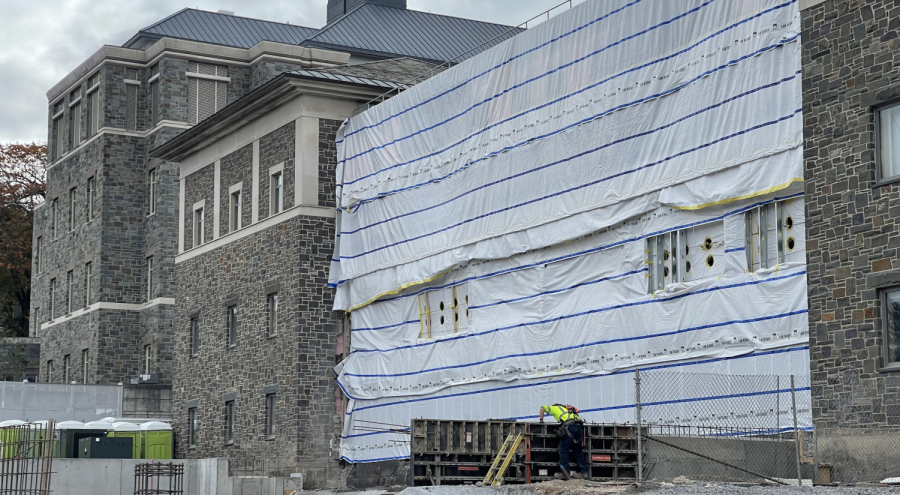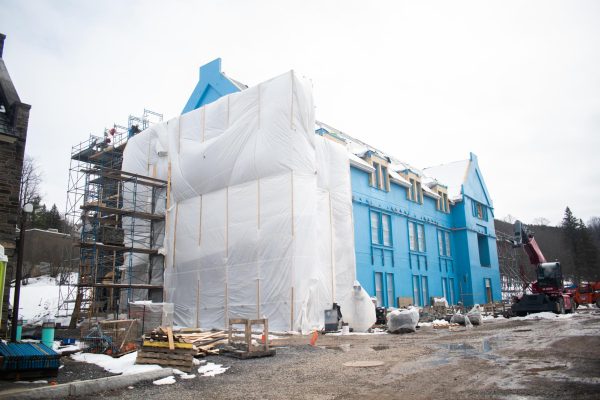Asbestos Found During Olin Hall Construction
Reports of the presence of asbestos were noted in Olin Hall during a renovation that began in the early summer, complicating efforts to the already-planned expansion.
The building has been closed since May 2022 when renovations began to modernize the building’s interior, HVAC and other building services, and fit out what will become the Robert H.N. Ho Mind, Brain, Behavior Initiative. It will be out of commission for the entire 2022-2023 academic year. President Brian Casey provided some updates on the status of the renovation and what exactly caused the asbestos in the first place. Casey first commented on the start of the construction and renovation.
“We’ve really torn that building apart,” Casey said. “We found, not in a way that was a threat to anyone, something of concern. We sealed up the building, and my understanding is that we have gotten the problem taken care of.”
Casey further explained the complexity of the renovation project.
“The project is more complicated than we thought,” Casey said. “We did not know what we would uncover when we unwrapped a building that was 60 years old. Our whole attitude has been ‘fix the building’ – I don’t think this is a shocking surprise. This is what happens when you take over a building of that size.”
Dr. Julia Martinez, chair of the Psychological and Brain Sciences Department, commented on the need for the renovations being made to Olin Hall and the information she has received as a community member who regularly uses the building.
“Asbestos and abatement are common to renovations for older buildings and so has been a topic of discussion from the start,” Martinez said. “All the regular inhabitants of Olin have been informed of the aspects of the renovation via meetings and communications with the project team as well as various members of the administration.”
Many professors have had to shift the locations of their offices and class due to the construction, and Martinez discussed how the asbestos and construction has changed how things have been set up.
“Asbestos has not had an impact on my sense of instruction or health while in Olin,” Martinez said. “Asbestos is common in old buildings and is safe when not disturbed. When we were still in Olin, we changed classrooms because of the pandemic. Demolition began after we were all safely out of the building. Once abatement is done and the renovation is finished, the building will be a safe, well-functioning, and attractive workplace.”
Sophomore Maddie Handley had a class in Olin Hall last semester and provided her thoughts on the renovation.
“Initially, I was really scared because of how dramatic everyone was making it seem,” Handley said. “I knew I would have many more classes in Olin, so I was curious to see where I would be learning instead. But, I think there was just a bit of fear initially because of the asbestos, and I really didn’t know what that even meant. I didn’t know if it was dangerous to our health or anything, but the fact that it was found and then renovations started scared me a bit.”
Handley further explained her appreciation for Colgate’s response to finding and properly handling the issue.
“I was really happy to see how quick to act Colgate was, and the precautions they took for all the students’ and faculties’ safety,” Handley said. “I am also glad to see how the school is communicating with us to keep us in the loop with things like this. It makes me glad to know [Colgate] will tackle problems with health and safety right away.”
Casey ended with some statements about his hopes for the renovation and what he envisions for the future.
“I just want to make sure that when it is done, it is the right building,” Casey said. “I don’t want some president 60 years from now opening up that building going ‘Casey, what did you do?’ I want this to be done the right way.”

Ethan Cherry is a senior from Baltimore, MD studying political science and architecture. He has previously served as multimedia manager, news editor, assistant...







